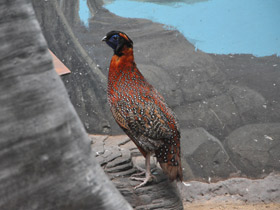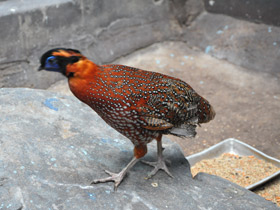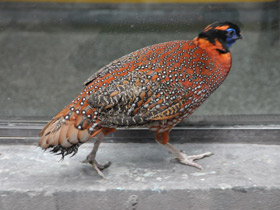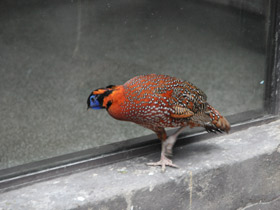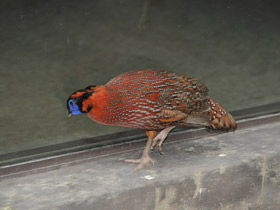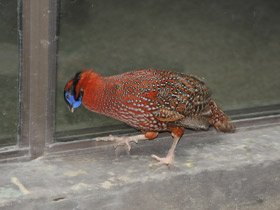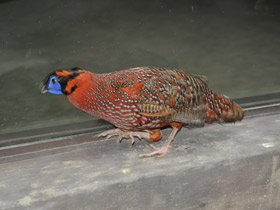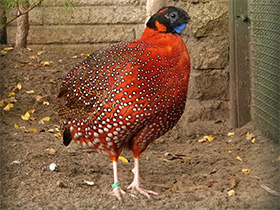The satyr trogopan Tragopan satyra
The satyr tragopan, also known as the crimson horned pheasant, is distributed across the central and eastern parts of the Himalayas in India, Bhutan, Nepal, and South China. It is usually found between 2,200 and 4,250 metres above sea level during the breeding season, descending as low as 1,400 m in winter. This species is characterized by pronounced dimorphism. The males have a beautiful colouration, featuring bright crimson-red colour of the neck and upper breast, and a thin black necklace. Body underparts and crop are dark reddish-brown to black, spotted with small, black-edged white dots. The male may reach a body length of 67–72 cm, weighing 1.5 to 2 kg. Females are much smaller; they measure about 60 cm in body length and weigh 1–1.5 kg. They are primarily brown with blackish blotching. Satyr tragopans are perfectly adapted to the continental climate of their habitats but do not tolerate high temperatures.
Typical biotops of these birds are presented by chilly, damp oak and coniferous forests with an understory of bamboo and rhododendron. They are also found in rocky areas or gorges with small streams and undergrowth of lilac, primrose, violets, and strawberry. Satyr tragopans are wary and secretive birds, and it is difficult to see them in their natural habitats. When startled, these birds will quickly fly into nearby scrub or grass thickets. Satyr tragopans mainly forage in the early morning and late afternoon but may be active in the daytime in cloudy weather. They feed predominantly on the greens, berries, and fruit, giving preference to the leaves and buds of rhododendron, ferns, daphne, and bastard cinnamon. They also eat bamboo shoots, seeds and bulbs, as well as various spiders and centipedes.
Satyr tragopans are solitary most of the year, establishing pairs only during the breeding season. Small brood flocks of these birds can be seen at the end of breeding season, when young fledge but are not yet independent. Satyr tragopans are monogamous and establish continuous pair bonds. The breeding season lasts from April to June. To attract the female’s attention the male comes close to the female, spreading his wings, inflating horns, and revealing his lappet. The male increasingly quivers and rustles his feathers, flapping the wings on the ground and producing a clacking sound. Then he moves closer to the female and quickly rustles his feathers, looking much larger. The courtship display usually occurs during sunrise period and may last about 30 minutes.
The nest is built in inaccessible scrub tickets on the ground or in trees. The female uses various nesting materials, including small sticks and twigs. A clutch consists of 4 to 8 eggs that are incubated by the female for 28–30 days. Rufous brown precocial chicks are able to fly after two or three days. They stay with the mother for their first year and reach sexual maturity by the age of two years.

















